Now & New
- Eat
Zona Italia in Centro: Savoring the Flipside of Shukkeien
The city center of Hiroshima gets lots of tourists, but unlike in Osaka and Tokyo, where they seem to be evenly distributed throughout the city, in Hiroshima, we get clusters of them in select parts of downtown. The three clusters that immediately surface to the mind are Hiroshima Station, Peace Memorial Park, Hiroshima Castle, and Shukkeien. Shukkeien is more than just a landscape garden as it is conjoined with the Hiroshima Prefectural Art Museum, but from my experience, I can say with utmost confidence that the former gets considerably more visitors than the latter. Those who enter the Prefectural Art Museum can occasionally look down onto a corner of Shukkeien, but for those who only tour the garden, all one can do is look through the glass windows and wonder what’s on the other side.
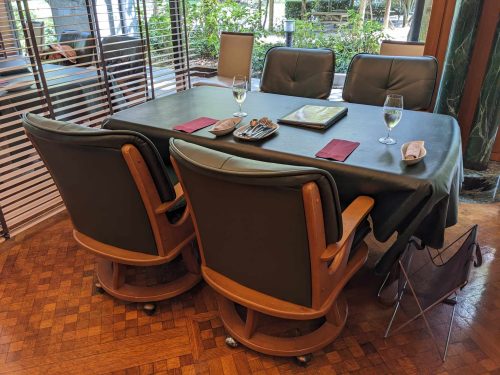
I had been curious about what looked like a fancy restaurant ever since taking a peep from Shukkeien while admiring the cherry blossoms in April and hydrangea in June, so I decided to walk in one day. The wait staff greeted me professionally and asked if I had a reservation, which I didn’t, leading me to leave and read the menu displayed outside. From the prices for the lunch courses alone (dinner would be even pricier) and the atmosphere of the restaurant from just going past the doors, I knew this was the kind of place people frequent on special days like anniversaries and such. I waited until the next time such an occasion would happen in my life and invited a companion to dine with me as well. When I called ahead to book a table, I was informed that reservations were not absolutely necessary, but highly recommended for Saturdays, Sundays, and public holidays to ensure diners can be seated promptly. On the day we visited, we were cordially guided to a reserved table with top-class, cushy chairs and a view of Shukkeien out the window.
I Tre Antipasti
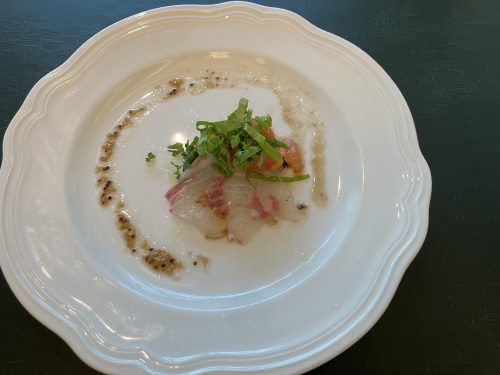
There are a total of four courses available for lunch: the pasta course that lets diners choose from a list of spaghetti in a wide array of flavors, a seafood course that features a fish dish in addition to a predetermined pasta (not on the pasta course list), a meat course wherein a meat dish is substituted for the fish dish, and a lavish spread that includes both the fish and meat dishes. We decided to have one person get the pasta course and the other order the meat course, both as a money-saving measure and for the purpose of comparing the foods served during each stage of the meal. After the waitress took our orders for drinks and meals, in minutes, we were graced with plates of seafood carpaccio, the first appetizer in every course. The picture above is of the carpaccio for the pasta course; the elaborate presentation of the fresh, marinated fish was stunning even though it was from the “cheaper” pasta course. Meanwhile, in the meat course that I ordered, I was presented with an equally ornate culinary canvas that in retrospect, probably had fewer pieces of fish on it.
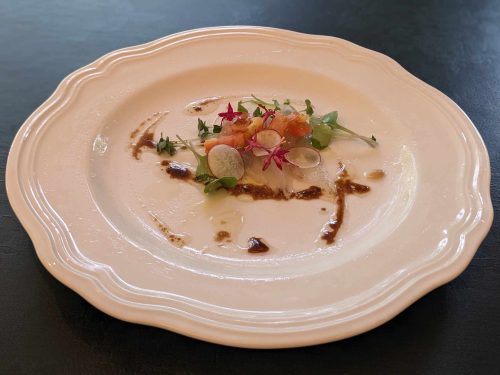
The second prelude to our main dishes was a piece of a hot baguette, available with fresh butter or flavored with garlic spread. We were told that there were unlimited refills on bread throughout the meal, but realistically, we would be too busy eating everything else afterward, so the appetizer was the only time we had bread. The pasta course’s second appetizer was this bowl of corn potage, which paired perfectly with the crispy baguette slices.
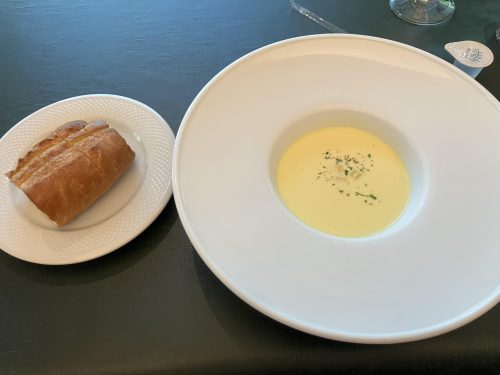
On the other hand, the meat course had a cold appetizer of prosciutto crudo al melone, something more authentically Italian and reminiscent of my university term spent in the Tuscan countryside. The smoky, raw ham was dressed in olive oil and accented with pink pepper powder, which brought out a richness that better accompanied the hot, fluffy bread. Being able to follow up the fish carpaccio with something meaty was a welcome change in pace, especially considering that I had ordered the meat course.
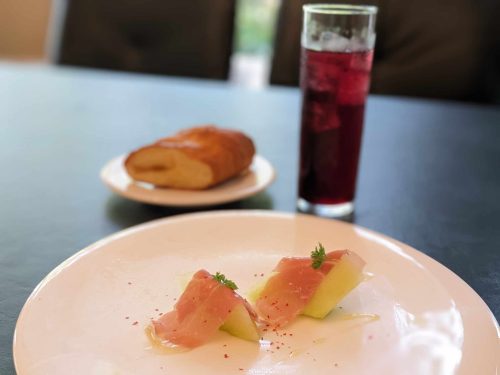
Yet another appetizer followed those dishes, and this stage was more substantial than the last. The pasta course had this piece of fish slathered in a white sauce and garnished with assorted vegetables. Using a gigantic plate to hold such little food almost seems like a waste of space, but I suppose the excess white space means more room for painting with sauces and seasonings.
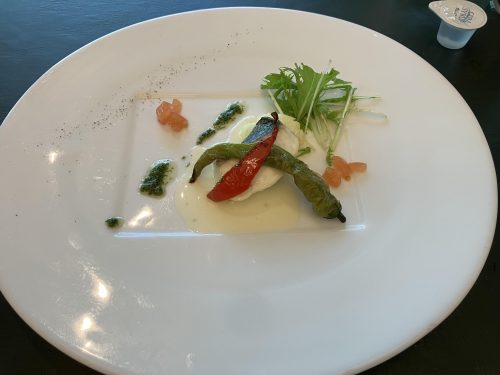
The last appetizer for the meat course was of course, also meat, but had contents and presentation that would rival my main course that day. I was presented with a panko-crusted slice of beef tongue imported from Spain, with cooked vegetables both on and underneath, as well as a puddle of raspberry sauce to the side for dipping. I had a grand old time smearing that dark red liquid all over my plate as I tore through the tongue, which was so tender I momentarily forgot what body part I was eating.
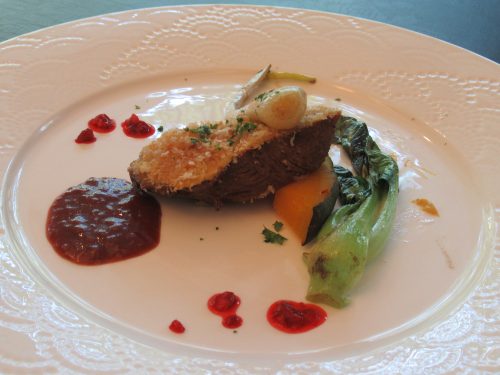
Primi, Secondi, e Dolci
As this is indeed an Italian restaurant, the menu used Italian terminology to refer to the various stages in our meals. Up until now, we have had three different types of antipasto (appetizer), which in the case of the meat or seafood course, can be divided into the carpaccio, the antipasto freddo (cold appetizer), and the antipasto caldo (hot appetizer). It wasn’t until now that the primo, or so-called “first course,” would be brought to our table, but our appetites were more than ready. In Italy, the primo is usually something starchy, like pasta, risotto, or polenta, and precedes the secondo, or “second course,” which would consist of meat, fish, or some other source of protein. However, in the case of the pasta course, the spaghetti dish itself is the main course, so such a distinction is unnecessary. Whereas the prices of the seafood, meat, and everything courses are fixed, the price of the pasta course depends on what type of pasta was ordered. My companion went with the sautéed eggplant and bacon spaghetti in tomato sauce, and while that was the cheapest option available, nothing about it looked or tasted inferior to what I got.

On my side, I had linguine in an aglio e olio (garlic and oil) sauce topped with sea urchin, clams, leafy greens, and dried seaweed. I was truly a fan of constantly switching between surf and turf over the course of my lunch, and despite the portion size being small, food that tastes this good makes you want to eat it slowly.
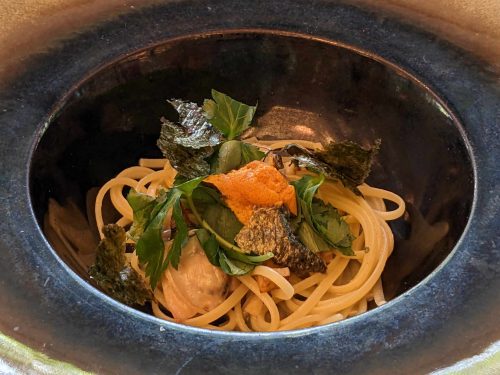
Then came the namesake of my meat course: wagyu beef filet “saltato (Italian for sauté)” paired with a fig and gorgonzola cheese-flavored balsamic vinaigrette. The beef had a hot, reddish center, which is just the way I like to eat beef, and the mild pepper and sprouts on top added some variety to the look and taste of the dish. As with my beef tongue from before, this one also looked to be a work of art, and once again, I had some fun painting the plate anew with my fork and food.
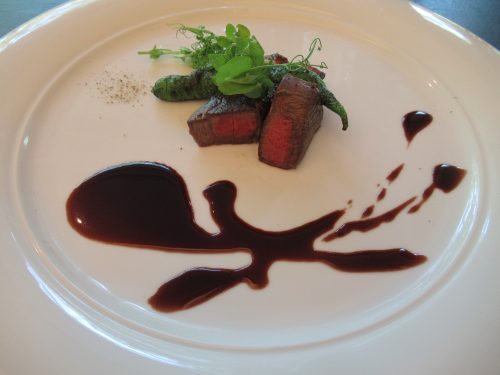
While I was munching on my secondo, I kept feeling like my companion was kept waiting since the pasta course had no secondo, but since the portion size of the tomato sauce spaghetti was larger than the little linguine I got, the timing actually worked out fine as we finished our main courses not too far apart from each other. The last stage of both meals was the dolce (Italian for “sweet”), both of which were desserts made in-house by a pâtissier, and the menu said no more than that so the only thing we could do was wait and see what they looked like. The pasta course’s dessert consisted of jelly with pears topped with a scoop of vanilla ice cream and blueberry sauce. Two puff pastry stars stuck to the rim of the plate were a cute addition to the dessert that made me want the same thing, but alas, my dessert was to be different.
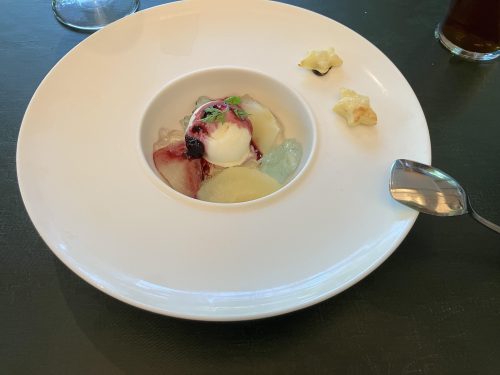
I was delighted to know that my dessert mainly differed in appearance, as I had the same vanilla ice cream with pears, but on a translucent plate without puff pastry stars. My dessert also came with a piece of berry-flavored cake and was decorated with chocolate pen and chunks of frozen raspberries. I guess paying more for a more elaborate course means more art on the plates and more opportunities to play with one’s food. In the end, my companion and I tried each other’s desserts anyway so there was no loss on anybody’s part. We gulped down the last of our beverages, and just like that, lunch was over and it was time to go.
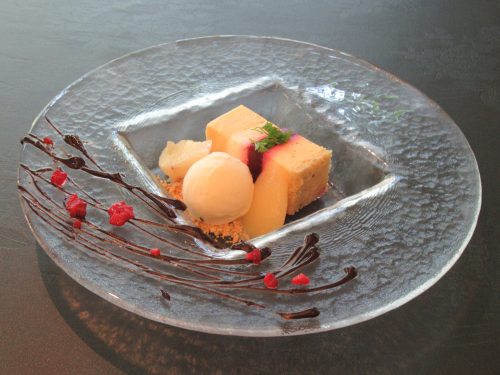
Tom Sawyer Tea Room
If the above desserts didn’t seem like enough, fret not, for besides Zona Italia in Centro, there are still other places to eat inside the Hiroshima Prefectural Art Museum. Tom Sawyer, the tea room on the third floor of the museum, is open until 5:00 p.m., and offers light fare for lunch in addition to countless sweets and hot beverages for visitors taking a break from the art galleries. In addition, there were limited-time items on their café menu, one of which was sold in conjunction with the “Delicious Botanical Art” special exhibit also held on the third floor from the 6th of October to the 26th of November. That exclusive one was a tea set that came with a piece of chocolat framboise cake, Walker shortbread (replaced with two chocolate cookies since they ran out), a scoop of vanilla ice cream, and a pot of seasonal tea (I chose the special Earl Grey, which the staff recommended). What’s more, I sat by the window, and the view I had from there was the exact same as what I got from Zona Italia in Centro, but two stories higher, allowing me a better vantage point of the leaves beginning to change color.
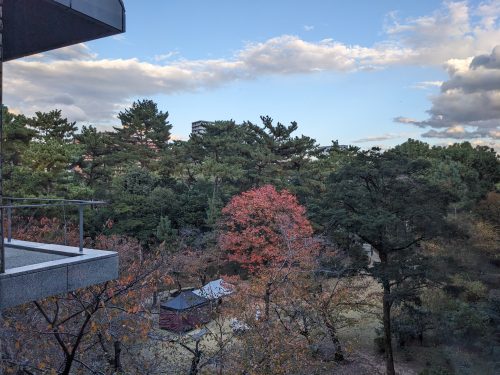
Moment of Joy: Timed Tea
My pot of Earl Grey was the first thing to come to the table, but that didn’t mean it was ready to drink right off the bat. The waitress notified me that it took four minutes to steep the tea, and placed a two-minute hourglass on my table that had already started running. She told me that when the sand completely finished falling, I should turn the hourglass over and wait another two minutes to pour and drink the tea, which I found quirky and amusing. It made me feel like I had a hand in preparing my tea set, and by the time my hourglass ran out a second time, my food was sitting before my eyes and I could start chowing down immediately.
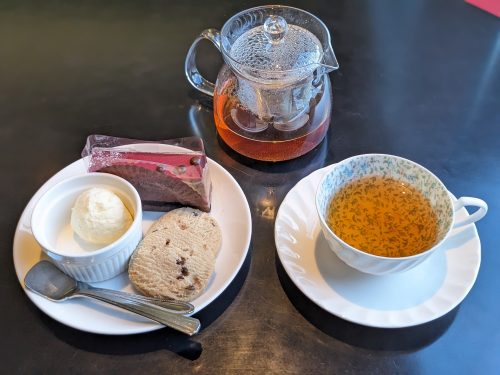
Appetizing Artwork
Of course, it would be remiss of me to only eat the food based off the culinary exhibit and not see the yummy art itself, so after tea time, I headed into the special exhibit hall on the same third floor. It was made up of three chambers, and because photography was forbidden in the former two chambers (save for a couple historical dining tables), I can only describe the contents as food-centric, the majority of which were scientific diagrams of various fruits and vegetables. The descriptions on the walls (in Japanese only) were also extremely informative, and told the history of popular food crops such as coffee, tea, sugar cane, chocolate, and plants used in alcoholic beverages. Regrettably, the former two chambers had better artwork and artifacts than the last one in my opinion, but the spread of the final dining table right before the gift shop won the beauty contest, hands down.
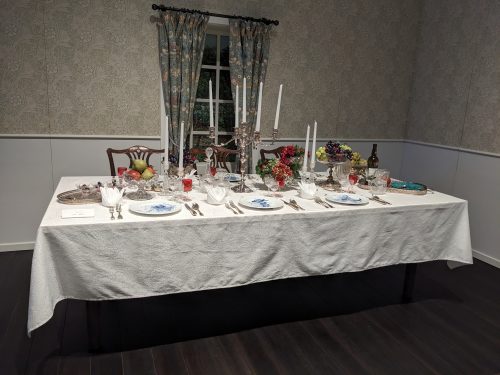
I was so mesmerized by everything I saw and read here that I barely left enough time for the regular exhibit, so I had to hurry down to the second floor. There were more photo opportunities to be had here, though, so I couldn’t afford to skip this segment even though I had been here several times in the past. That said, even though the bulk of the artwork here has remained unchanged since the last time I visited, there are always a few sections of the normal exhibit that are either new to me or are pieces that I forgot I even saw. The majority of the paintings on the second floor are still life paintings of mundane objects, many of which are food too, but there are also works by famous Western artists, like The Dream of Venus by Salvador Dalí and masterpieces by renowned Nihonga figures such as Plants and Creatures (草花図 – そうかず) by Fukuhara Gogaku. One of the still life paintings that stood out to me the most was this one by Alexander Kanoldt; it may not look as appetizing as the works in the special exhibit hall, but it reminded me of them.
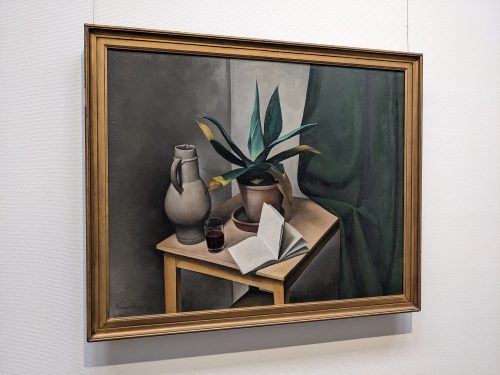
It was close to closing time when I was touring the regular exhibit hall, so I had to rush through the latter half and didn’t get to pause to take photos of everything I wanted to photograph. Most of the items on display were familiar to me, though, so it wasn’t a big loss in my book. The final room was filled with textiles and other artifacts from Central Asia; that room gets its stuff rotated the most often so it alone warrants seeing the normal exhibit on a regular basis.
A fancy outing at the Hiroshima Prefectural Art Museum complex is indeed not a plan to be underestimated, whether or not Shukkeien is included. In particular, having lunch at Zona Italia in Centro before or between exhibits is an experience certain not to disappoint, so call ahead to ensure your table by the garden and be the envy of those casually viewing flowers outdoors. Shukkeien right outside the building may be an obvious choice when it comes to tourist attractions in Hiroshima, but the museum’s exhibits, tea room, and restaurant is a testament to the adage, “it’s what’s on the inside that counts.”
Written by the Joy in Hiroshima Team
